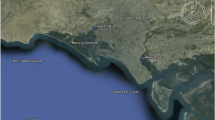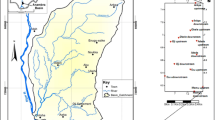Abstract
East Calcutta Wetlands, a Ramsar site, receives a huge amount of the city’s composite industrial effluent (∼600 million liters per day) throughout the year. The waste-element-contaminated water flows down through a major storm water flow (SWF) canal into the wetland for nearly 40 km farther eastward and is finally discharged into Kultigong river that flows through the eastern limit of the wetland and that in turn unites with river Ganga. Elemental load in water and bottom sediment at selected sites of the SWF canal was assessed by proton-induced X-ray emission and atomic absorption spectroscopy techniques. Gradual decrease in concentration levels of elements was observed in both water and bottom sediments of SWF canal up to its site of confluence at Kultigong, indicating natural remediation processes taking place along the canal up to the confluence at Ganga estuary. Any further conversion of this wetland area should be prevented to get the benefit from this no-cost natural cleanup process in connection to pollution prevention.
Similar content being viewed by others
References
Aprilesi, G., Cecchi, R., Ghermandi, G., Magnoni, G., & Santangelo, R. (1984). Calibration and errors in the detection of heavy metals in fresh and sea waters by PIXE in the ppb–ppm range. NIMB, 3, 172–176.
Bartlett, R. J. (1999). Characterizing soil redox behavior. In D. L. Sparks (Ed.), Soil physical chemistry (pp. 371–391). Boca Raton: CRC.
Bradl, H. B. (2004). Adsorption of heavy metal ions on soils and soils constituents. Journal of Colloid and Interface Science, 277, 1–18.
Bryan, G. W., & Langston, W. J. (1992). Bioavailability, accumulation and effects of heavy metals in sediments with special reference to United Kingdom estuaries: A review. Environmental Pollution, 76, 89–131.
Chatterjee, S., Chattopadhyay, B., & Mukhopadhyay, S. K. (2006). Heavy metal distribution in tissues of cichlids (Oreochromis niloticus and O. mossambicus) collected from wastewater-fed fishponds in East Calcutta Wetlands, a Ramsar site. Acta Ichthyologica et Piscatoria, 36(2), 119–125.
Chatterjee, S., Chattopadhyay, B., Mukhopadhyay, S. K., Mohanta, B., Sudarshan, M., & Chakraborty, A. (2007). East Calcutta Wetlands as a sink of industrial heavy metals: A PIXE study. International Journal of PIXE, 17(3–4), 129–142.
Chattopadhyay, B. (2002). Physico-chemical and biological characterization of tannery effluents envisaging environmental impact assessment from ecotoxicological standpoint. Ph.D. thesis, Jadavpur University, India.
Chattopadhyay, B., Gupta, R., Chatterjee, A., & Mukhopadhyay, S. K. (1999). Characterization of tannery effluents envisaging environmental impact assessment. Journal of American Leather Chemists’ Association, 94(9), 338–347.
Chattopadhyay, B., Chatterjee, S., & Mukhopadhyay, S. K. (2004). Seasonality in physico-chemical parameters of tannery wastewater passing through East Calcutta Wetland ecosystem. Journal of Society for Leather Technologists & Chemists, 88, 27–36.
Chattopadhyay, B., Gupta, R., & Mukhopadhyay, S. K. (2000). Physico-chemical and biological characterization of effluent from Calcutta Tanneries. In B. B. Jana, R. D. Banerjee, B. Gutersta, & J. Heeb (Eds.), Waste recycling and resource management in the developing world: Ecological approach (pp. 361–371). Kalyani and Lucerne: Univ. Kalyani and International Ecological Engineering Society.
Day, J. W., Jr., Ko, J. Y., Rybczyk, J., Sabins, D., Bean, R., Berthelot, G., et al. (2004). The use of wetlands in the Mississippi Delta for wastewater assimilation: A review. Ocean & Coastal Management, 47, 671–691.
DePinto, J. V., & Martin, S. C. (1980). Aquatic sediments. Journal—Water Pollution Control Federation, 52(6), 1656–1670.
Eaton, A. D., Clesceri, L. S., & Greenberg, A. E. (1995). Standard methods of the examination of water and wastewater (19th Ed.). Washington D.C.: APHA.
Ghosh, S. K. (2004). Traditional and commercial practices in sustainable development and conservation of man and wetlands. In Knowledge marketplace reports: The 3rd IUCN world conservation congress (pp. 1–6). Bangkok, Thailand.
Ghosh, S. K., & Ghosh, D. (2003). Rehabilitating biodiversity: A community based initiative in the East Calcutta Wetlands (pp. 6–11). Calcutta: WWF-India (WBSO) and British Council Division.
Khagan, V. W., Bankar, D. B., & Dara, S. S. (1996). Binding of copper ions with modified Aegle marmelos bark substrate. Journal of Industrial Pollution Control, 12(2), 97–108.
Liang, Y. (2007). Field assessment of sediment toxicities within subtropical estuarine wetland in Hong Kong, using a local gastropod (Sermyla tornatella). Bulletin of Environmental Contamination and Toxicology, 78, 494–498.
Liang, Y., & Wong, M. H. (2004). Heavy metal mobility and aquatic biogeochemical processes at Mai Po Marshes Nature Reserve, Hong Kong. In M. H. Wong (Ed.), Wetland ecosystems in Asia function and management (pp. 69–85). Amsterdam: Elsevier.
Mehta, B. H., & Churi, A. J. (1996). Study of various effluents, flowing on the ground, around Tarapur Industrial Estate, Thane. Journal of Industrial Pollution & Contamination, 12(2), 153–162.
Nyangababo, J. T., Henry, L., & Omutange, E. (2005). Lead, cadmium, copper, manganese and zinc in wetland waters of Victoria Lake basin, East Africa. Bulletin of Environmental Contamination & Toxicology, 74, 1003–1010.
Okoronkwo, N. E., Igwe, J. C., & Onwuchekwa, E. C. (2005). Risk and health implications of polluted soils for crop production. African Journal of Biotechnology, 4(23), 1521–1524.
Reed, S. C. (1991). Constructed wetlands for wastewater treatment. Biocycle, 32, 44–49.
Stoecker, B. (2004). Chromium. In E. Merian, M. Anke, M. Ihnat, & M. Stoeppler (Eds.), Elements and their compounds in the environment (pp. 709–729). Weinheim: Wiley.
Stumm, W. (1996). The solid–water interface in natural systems. In: D. L. Macalady (Ed.), Perspectives in environmental chemistry (pp. 3–24). New York: Oxford University Press.
Sudarshan, M., Datta, R. K., Vijayan, V., & Chintalapudi, S. N. (2000). PIXE measurements of drinking water of Salt Lake, Kolkata, India. Nuclear Instrumentation & Methods-B, 168, 553–558.
Vallius, H. (1999). Heavy metal deposition and variation in sedimentation rate within a sedimentary basin in central Gulf of Finland. Chemosphere, 38(9), 1959–1972.
Welz, B., & Sperling, M. (1999). Atomic absorption spectrometry (3rd completely revised Ed.). Weinheim: Wiley.
Zhang, M., Alva, A. K., Li, Y., & Calvert, C. V. (1997). Fractionation of iron, manganese, aluminum and phosphorus in selected sandy soils under citrus production. Journal of Soil Science Society America, 61, 794–801.
Author information
Authors and Affiliations
Corresponding author
Rights and permissions
About this article
Cite this article
Chatterjee, S., Chattopadhyay, B. & Mukhopadhyay, S.K. Monitoring waste metal pollution at Ganga Estuary via the East Calcutta Wetland areas. Environ Monit Assess 170, 23–31 (2010). https://doi.org/10.1007/s10661-009-1211-3
Received:
Accepted:
Published:
Issue Date:
DOI: https://doi.org/10.1007/s10661-009-1211-3




